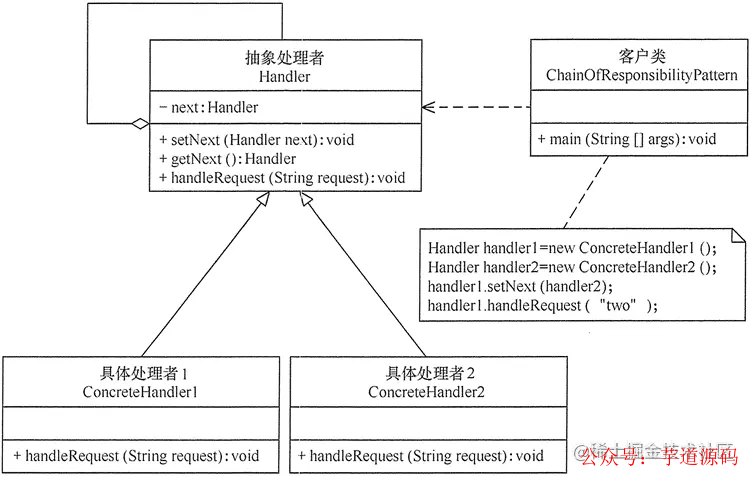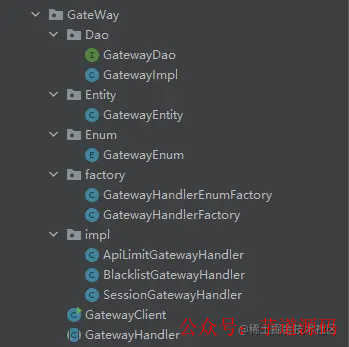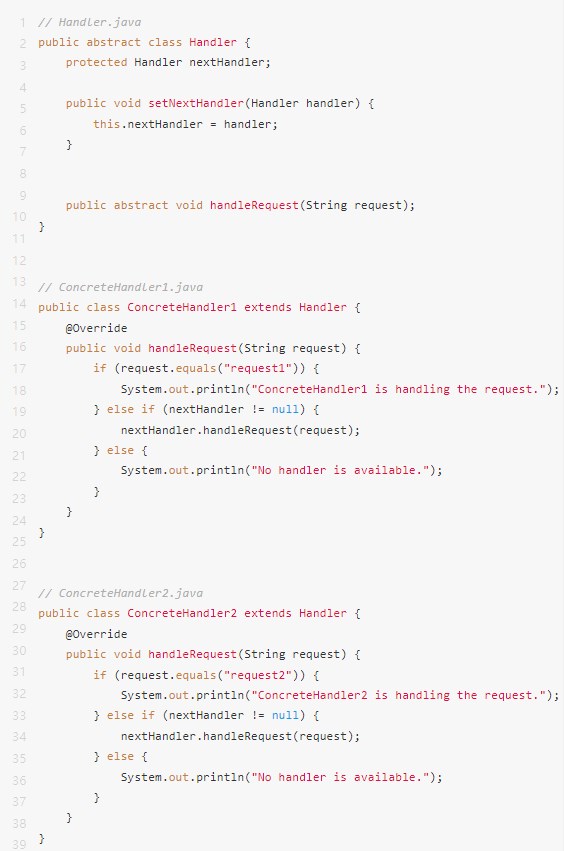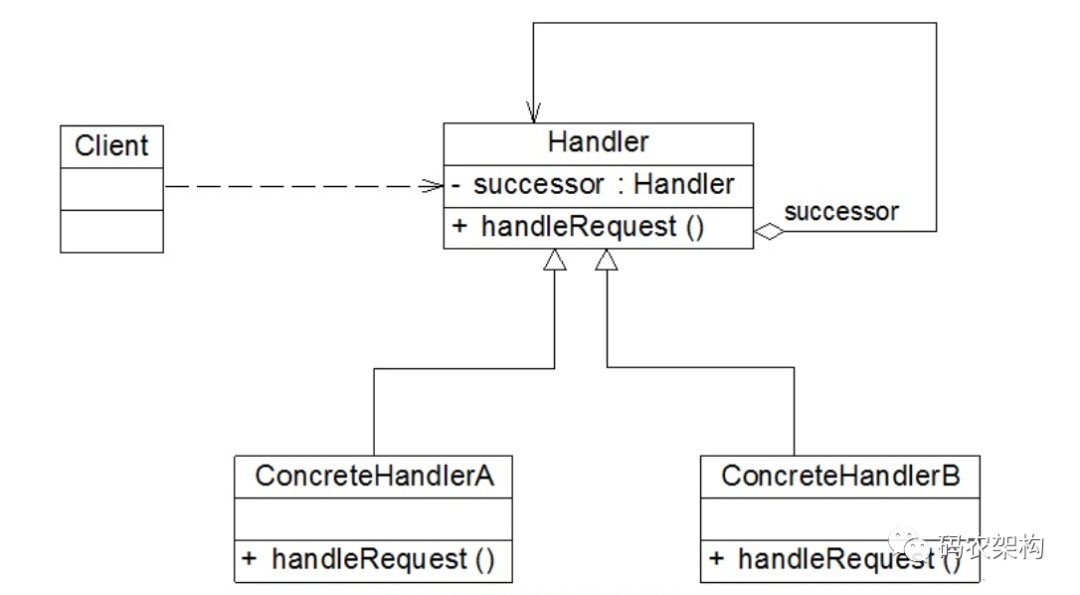什么是責(zé)任鏈
使用場景
反例
初步改造
缺點(diǎn)
責(zé)任鏈改造
責(zé)任鏈工廠改造
結(jié)語
最近,我讓團(tuán)隊(duì)內(nèi)一位成員寫了一個(gè)導(dǎo)入功能。他使用了責(zé)任鏈模式,代碼堆的非常多,bug 也多,沒有達(dá)到我預(yù)期的效果。
實(shí)際上,針對導(dǎo)入功能,我認(rèn)為模版方法更合適!為此,隔壁團(tuán)隊(duì)也拿出我們的案例,進(jìn)行了集體 code review。
學(xué)好設(shè)計(jì)模式,且不要為了練習(xí),強(qiáng)行使用!讓原本 100 行就能實(shí)現(xiàn)的功能,寫了 3000 行!對錯(cuò)暫且不論,我們先一起看看責(zé)任鏈設(shè)計(jì)模式吧!
什么是責(zé)任鏈
責(zé)任鏈模式是一種行為設(shè)計(jì)模式, 允許你將請求沿著處理者鏈進(jìn)行發(fā)送。收到請求后, 每個(gè)處理者均可對請求進(jìn)行處理, 或?qū)⑵鋫鬟f給鏈上的下個(gè)處理者。

基于 Spring Boot + MyBatis Plus + Vue & Element 實(shí)現(xiàn)的后臺(tái)管理系統(tǒng) + 用戶小程序,支持 RBAC 動(dòng)態(tài)權(quán)限、多租戶、數(shù)據(jù)權(quán)限、工作流、三方登錄、支付、短信、商城等功能
項(xiàng)目地址:https://github.com/YunaiV/ruoyi-vue-pro
視頻教程:https://doc.iocoder.cn/video/
使用場景
責(zé)任鏈的使用場景還是比較多的:
多條件流程判斷:權(quán)限控制
ERP 系統(tǒng)流程審批:總經(jīng)理、人事經(jīng)理、項(xiàng)目經(jīng)理
Java 過濾器的底層實(shí)現(xiàn) Filter
如果不使用該設(shè)計(jì)模式,那么當(dāng)需求有所改變時(shí),就會(huì)使得代碼臃腫或者難以維護(hù),例如下面的例子。
反例
假設(shè)現(xiàn)在有一個(gè)闖關(guān)游戲,進(jìn)入下一關(guān)的條件是上一關(guān)的分?jǐn)?shù)要高于 xx:
游戲一共 3 個(gè)關(guān)卡
進(jìn)入第二關(guān)需要第一關(guān)的游戲得分大于等于 80
進(jìn)入第三關(guān)需要第二關(guān)的游戲得分大于等于 90
那么代碼可以這樣寫:
//第一關(guān) publicclassFirstPassHandler{ publicinthandler(){ System.out.println("第一關(guān)-->FirstPassHandler"); return80; } } //第二關(guān) publicclassSecondPassHandler{ publicinthandler(){ System.out.println("第二關(guān)-->SecondPassHandler"); return90; } } //第三關(guān) publicclassThirdPassHandler{ publicinthandler(){ System.out.println("第三關(guān)-->ThirdPassHandler,這是最后一關(guān)啦"); return95; } } //客戶端 publicclassHandlerClient{ publicstaticvoidmain(String[]args){ FirstPassHandlerfirstPassHandler=newFirstPassHandler();//第一關(guān) SecondPassHandlersecondPassHandler=newSecondPassHandler();//第二關(guān) ThirdPassHandlerthirdPassHandler=newThirdPassHandler();//第三關(guān) intfirstScore=firstPassHandler.handler(); //第一關(guān)的分?jǐn)?shù)大于等于80則進(jìn)入第二關(guān) if(firstScore>=80){ intsecondScore=secondPassHandler.handler(); //第二關(guān)的分?jǐn)?shù)大于等于90則進(jìn)入第二關(guān) if(secondScore>=90){ thirdPassHandler.handler(); } } } }
那么如果這個(gè)游戲有 100 關(guān),我們的代碼很可能就會(huì)寫成這個(gè)樣子:
if(第1關(guān)通過){
//第2關(guān)游戲
if(第2關(guān)通過){
//第3關(guān)游戲
if(第3關(guān)通過){
//第4關(guān)游戲
if(第4關(guān)通過){
//第5關(guān)游戲
if(第5關(guān)通過){
//第6關(guān)游戲
if(第6關(guān)通過){
//...
}
}
}
}
}
}
這種代碼不僅冗余,并且當(dāng)我們要將某兩關(guān)進(jìn)行調(diào)整時(shí)會(huì)對代碼非常大的改動(dòng),這種操作的風(fēng)險(xiǎn)是很高的,因此,該寫法非常糟糕。
初步改造
如何解決這個(gè)問題,我們可以通過鏈表將每一關(guān)連接起來,形成責(zé)任鏈的方式,第一關(guān)通過后是第二關(guān),第二關(guān)通過后是第三關(guān)....
這樣客戶端就不需要進(jìn)行多重 if 的判斷了:
publicclassFirstPassHandler{
/**
*第一關(guān)的下一關(guān)是第二關(guān)
*/
privateSecondPassHandlersecondPassHandler;
publicvoidsetSecondPassHandler(SecondPassHandlersecondPassHandler){
this.secondPassHandler=secondPassHandler;
}
//本關(guān)卡游戲得分
privateintplay(){
return80;
}
publicinthandler(){
System.out.println("第一關(guān)-->FirstPassHandler");
if(play()>=80){
//分?jǐn)?shù)>=80并且存在下一關(guān)才進(jìn)入下一關(guān)
if(this.secondPassHandler!=null){
returnthis.secondPassHandler.handler();
}
}
return80;
}
}
publicclassSecondPassHandler{
/**
*第二關(guān)的下一關(guān)是第三關(guān)
*/
privateThirdPassHandlerthirdPassHandler;
publicvoidsetThirdPassHandler(ThirdPassHandlerthirdPassHandler){
this.thirdPassHandler=thirdPassHandler;
}
//本關(guān)卡游戲得分
privateintplay(){
return90;
}
publicinthandler(){
System.out.println("第二關(guān)-->SecondPassHandler");
if(play()>=90){
//分?jǐn)?shù)>=90并且存在下一關(guān)才進(jìn)入下一關(guān)
if(this.thirdPassHandler!=null){
returnthis.thirdPassHandler.handler();
}
}
return90;
}
}
publicclassThirdPassHandler{
//本關(guān)卡游戲得分
privateintplay(){
return95;
}
/**
*這是最后一關(guān),因此沒有下一關(guān)
*/
publicinthandler(){
System.out.println("第三關(guān)-->ThirdPassHandler,這是最后一關(guān)啦");
returnplay();
}
}
publicclassHandlerClient{
publicstaticvoidmain(String[]args){
FirstPassHandlerfirstPassHandler=newFirstPassHandler();//第一關(guān)
SecondPassHandlersecondPassHandler=newSecondPassHandler();//第二關(guān)
ThirdPassHandlerthirdPassHandler=newThirdPassHandler();//第三關(guān)
firstPassHandler.setSecondPassHandler(secondPassHandler);//第一關(guān)的下一關(guān)是第二關(guān)
secondPassHandler.setThirdPassHandler(thirdPassHandler);//第二關(guān)的下一關(guān)是第三關(guān)
//說明:因?yàn)榈谌P(guān)是最后一關(guān),因此沒有下一關(guān)
//開始調(diào)用第一關(guān)每一個(gè)關(guān)卡是否進(jìn)入下一關(guān)卡在每個(gè)關(guān)卡中判斷
firstPassHandler.handler();
}
}
缺點(diǎn)
現(xiàn)有模式的缺點(diǎn):
每個(gè)關(guān)卡中都有下一關(guān)的成員變量并且是不一樣的,形成鏈很不方便
代碼的擴(kuò)展性非常不好
責(zé)任鏈改造
既然每個(gè)關(guān)卡中都有下一關(guān)的成員變量并且是不一樣的,那么我們可以在關(guān)卡上抽象出一個(gè)父類或者接口,然后每個(gè)具體的關(guān)卡去繼承或者實(shí)現(xiàn)。
有了思路,我們先來簡單介紹一下責(zé)任鏈設(shè)計(jì)模式的基本組成:
抽象處理者(Handler)角色: 定義一個(gè)處理請求的接口,包含抽象處理方法和一個(gè)后繼連接。
具體處理者(Concrete Handler)角色: 實(shí)現(xiàn)抽象處理者的處理方法,判斷能否處理本次請求,如果可以處理請求則處理,否則將該請求轉(zhuǎn)給它的后繼者。
客戶類(Client)角色: 創(chuàng)建處理鏈,并向鏈頭的具體處理者對象提交請求,它不關(guān)心處理細(xì)節(jié)和請求的傳遞過程。

publicabstractclassAbstractHandler{
/**
*下一關(guān)用當(dāng)前抽象類來接收
*/
protectedAbstractHandlernext;
publicvoidsetNext(AbstractHandlernext){
this.next=next;
}
publicabstractinthandler();
}
publicclassFirstPassHandlerextendsAbstractHandler{
privateintplay(){
return80;
}
@Override
publicinthandler(){
System.out.println("第一關(guān)-->FirstPassHandler");
intscore=play();
if(score>=80){
//分?jǐn)?shù)>=80并且存在下一關(guān)才進(jìn)入下一關(guān)
if(this.next!=null){
returnthis.next.handler();
}
}
returnscore;
}
}
publicclassSecondPassHandlerextendsAbstractHandler{
privateintplay(){
return90;
}
publicinthandler(){
System.out.println("第二關(guān)-->SecondPassHandler");
intscore=play();
if(score>=90){
//分?jǐn)?shù)>=90并且存在下一關(guān)才進(jìn)入下一關(guān)
if(this.next!=null){
returnthis.next.handler();
}
}
returnscore;
}
}
publicclassThirdPassHandlerextendsAbstractHandler{
privateintplay(){
return95;
}
publicinthandler(){
System.out.println("第三關(guān)-->ThirdPassHandler");
intscore=play();
if(score>=95){
//分?jǐn)?shù)>=95并且存在下一關(guān)才進(jìn)入下一關(guān)
if(this.next!=null){
returnthis.next.handler();
}
}
returnscore;
}
}
publicclassHandlerClient{
publicstaticvoidmain(String[]args){
FirstPassHandlerfirstPassHandler=newFirstPassHandler();//第一關(guān)
SecondPassHandlersecondPassHandler=newSecondPassHandler();//第二關(guān)
ThirdPassHandlerthirdPassHandler=newThirdPassHandler();//第三關(guān)
//和上面沒有更改的客戶端代碼相比,只有這里的set方法發(fā)生變化,其他都是一樣的
firstPassHandler.setNext(secondPassHandler);//第一關(guān)的下一關(guān)是第二關(guān)
secondPassHandler.setNext(thirdPassHandler);//第二關(guān)的下一關(guān)是第三關(guān)
//說明:因?yàn)榈谌P(guān)是最后一關(guān),因此沒有下一關(guān)
//從第一個(gè)關(guān)卡開始
firstPassHandler.handler();
}
}
責(zé)任鏈工廠改造
對于上面的請求鏈,我們也可以把這個(gè)關(guān)系維護(hù)到配置文件中或者一個(gè)枚舉中。我將使用枚舉來教會(huì)大家怎么動(dòng)態(tài)的配置請求鏈并且將每個(gè)請求者形成一條調(diào)用鏈。

publicenumGatewayEnum{
//handlerId,攔截者名稱,全限定類名,preHandlerId,nextHandlerId
API_HANDLER(newGatewayEntity(1,"api接口限流","cn.dgut.design.chain_of_responsibility.GateWay.impl.ApiLimitGatewayHandler",null,2)),
BLACKLIST_HANDLER(newGatewayEntity(2,"黑名單攔截","cn.dgut.design.chain_of_responsibility.GateWay.impl.BlacklistGatewayHandler",1,3)),
SESSION_HANDLER(newGatewayEntity(3,"用戶會(huì)話攔截","cn.dgut.design.chain_of_responsibility.GateWay.impl.SessionGatewayHandler",2,null)),
;
GatewayEntitygatewayEntity;
publicGatewayEntitygetGatewayEntity(){
returngatewayEntity;
}
GatewayEnum(GatewayEntitygatewayEntity){
this.gatewayEntity=gatewayEntity;
}
}
publicclassGatewayEntity{
privateStringname;
privateStringconference;
privateIntegerhandlerId;
privateIntegerpreHandlerId;
privateIntegernextHandlerId;
}
publicinterfaceGatewayDao{
/**
*根據(jù)handlerId獲取配置項(xiàng)
*@paramhandlerId
*@return
*/
GatewayEntitygetGatewayEntity(IntegerhandlerId);
/**
*獲取第一個(gè)處理者
*@return
*/
GatewayEntitygetFirstGatewayEntity();
}
publicclassGatewayImplimplementsGatewayDao{
/**
*初始化,將枚舉中配置的handler初始化到map中,方便獲取
*/
privatestaticMapgatewayEntityMap=newHashMap<>();
static{
GatewayEnum[]values=GatewayEnum.values();
for(GatewayEnumvalue:values){
GatewayEntitygatewayEntity=value.getGatewayEntity();
gatewayEntityMap.put(gatewayEntity.getHandlerId(),gatewayEntity);
}
}
@Override
publicGatewayEntitygetGatewayEntity(IntegerhandlerId){
returngatewayEntityMap.get(handlerId);
}
@Override
publicGatewayEntitygetFirstGatewayEntity(){
for(Map.Entryentry:gatewayEntityMap.entrySet()){
GatewayEntityvalue=entry.getValue();
//沒有上一個(gè)handler的就是第一個(gè)
if(value.getPreHandlerId()==null){
returnvalue;
}
}
returnnull;
}
}
publicclassGatewayHandlerEnumFactory{
privatestaticGatewayDaogatewayDao=newGatewayImpl();
//提供靜態(tài)方法,獲取第一個(gè)handler
publicstaticGatewayHandlergetFirstGatewayHandler(){
GatewayEntityfirstGatewayEntity=gatewayDao.getFirstGatewayEntity();
GatewayHandlerfirstGatewayHandler=newGatewayHandler(firstGatewayEntity);
if(firstGatewayHandler==null){
returnnull;
}
GatewayEntitytempGatewayEntity=firstGatewayEntity;
IntegernextHandlerId=null;
GatewayHandlertempGatewayHandler=firstGatewayHandler;
//迭代遍歷所有handler,以及將它們鏈接起來
while((nextHandlerId=tempGatewayEntity.getNextHandlerId())!=null){
GatewayEntitygatewayEntity=gatewayDao.getGatewayEntity(nextHandlerId);
GatewayHandlergatewayHandler=newGatewayHandler(gatewayEntity);
tempGatewayHandler.setNext(gatewayHandler);
tempGatewayHandler=gatewayHandler;
tempGatewayEntity=gatewayEntity;
}
//返回第一個(gè)handler
returnfirstGatewayHandler;
}
/**
*反射實(shí)體化具體的處理者
*@paramfirstGatewayEntity
*@return
*/
privatestaticGatewayHandlernewGatewayHandler(GatewayEntityfirstGatewayEntity){
//獲取全限定類名
StringclassName=firstGatewayEntity.getConference();
try{
//根據(jù)全限定類名,加載并初始化該類,即會(huì)初始化該類的靜態(tài)段
Classclazz=Class.forName(className);
return(GatewayHandler)clazz.newInstance();
}catch(ClassNotFoundException|IllegalAccessException|InstantiationExceptione){
e.printStackTrace();
}
returnnull;
}
}
publicclassGetewayClient{
publicstaticvoidmain(String[]args){
GetewayHandlerfirstGetewayHandler=GetewayHandlerEnumFactory.getFirstGetewayHandler();
firstGetewayHandler.service();
}
}
基于 Spring Cloud Alibaba + Gateway + Nacos + RocketMQ + Vue & Element 實(shí)現(xiàn)的后臺(tái)管理系統(tǒng) + 用戶小程序,支持 RBAC 動(dòng)態(tài)權(quán)限、多租戶、數(shù)據(jù)權(quán)限、工作流、三方登錄、支付、短信、商城等功能
項(xiàng)目地址:https://github.com/YunaiV/yudao-cloud
視頻教程:https://doc.iocoder.cn/video/
結(jié)語
設(shè)計(jì)模式有很多,責(zé)任鏈只是其中的一種,我覺得很有意思,非常值得一學(xué)。設(shè)計(jì)模式確實(shí)是一門藝術(shù),仍需努力呀!
-
程序
+關(guān)注
關(guān)注
117文章
3787瀏覽量
81072 -
代碼
+關(guān)注
關(guān)注
30文章
4790瀏覽量
68650 -
RBAC
+關(guān)注
關(guān)注
0文章
44瀏覽量
9973
原文標(biāo)題:代碼精簡10倍,責(zé)任鏈模式y(tǒng)yds
文章出處:【微信號:芋道源碼,微信公眾號:芋道源碼】歡迎添加關(guān)注!文章轉(zhuǎn)載請注明出處。
發(fā)布評論請先 登錄
相關(guān)推薦
為什么使用菊花鏈配置模式對FPGA編程會(huì)失敗?
嵌入式系統(tǒng)的知識平臺(tái)與平臺(tái)模式詳解
電子行業(yè)供應(yīng)鏈責(zé)任向前邁出一步
區(qū)塊鏈技術(shù)有哪些特點(diǎn)_區(qū)塊鏈技術(shù)應(yīng)用_區(qū)塊鏈技術(shù)的工作原理
半導(dǎo)體芯片行業(yè)的運(yùn)作模式是什么(IDM/Fabless/Foundry模式)
C語言設(shè)計(jì)模式的程序資料合集
一起看看責(zé)任鏈設(shè)計(jì)模式吧!
什么是責(zé)任鏈?
如何用責(zé)任鏈默認(rèn)優(yōu)雅地進(jìn)行參數(shù)校驗(yàn)
設(shè)計(jì)模式行為型:責(zé)任鏈模式
設(shè)計(jì)模式之責(zé)任鏈模式概述

還在自己實(shí)現(xiàn)責(zé)任鏈?我建議你造輪子之前先看看這個(gè)開源項(xiàng)目





 責(zé)任鏈設(shè)計(jì)模式詳解
責(zé)任鏈設(shè)計(jì)模式詳解

![HS6621 串口透傳 <b class='flag-5'>模式</b> - [<b class='flag-5'>詳解</b>]](https://file.elecfans.com/web1/M00/D9/4E/pIYBAF_1ac2Ac0EEAABDkS1IP1s689.png)











評論